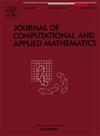The large time step scheme of Euler equations with source terms for nozzle flows
IF 2.6
2区 数学
Q1 MATHEMATICS, APPLIED
Journal of Computational and Applied Mathematics
Pub Date : 2025-06-16
DOI:10.1016/j.cam.2025.116867
引用次数: 0
Abstract
Hyperbolic conservation laws with source terms govern critical flow phenomena, including turbulence transport and hypersonic chemically reacting flows. Despite their engineering significance, traditional numerical schemes for these systems face strict CFL (≤1.0) constraints, limiting computational efficiency. This study addresses the computational challenges posed by geometric source terms in Euler equations governing compressible nozzle flows. The proposed approach decomposes the governing equations into convective and source components: while convection is resolved via an LTS Godunov scheme, geometric source terms—arising from nozzle area variations (quasi-1D) or cylindrical coordinate transformations (2D axisymmetric)—are discretized using a novel combination of explicit and exact schemes. Numerical validations include: (1) quasi-1D cases under supersonic start/non-start conditions (internal shocks near outlets) at CFL ≤8.0, demonstrating shock-capturing accuracy with 55 % RMS error reduction at CFL = 8.0; (2) 2D hypersonic nozzle flows (Mach 4.0 design), achieving stable simulations at CFL = 5.0 with <1 % exit Mach deviation and 66 % runtime reduction. Results confirm that the proposed LTS framework overcomes CFL ≤1.0 limitations while enhancing efficiency—computational costs and errors decrease monotonically with increasing CFL numbers. This method establishes a generalizable paradigm for stiff, multidimensional Euler systems, balancing robustness and accuracy without sacrificing explicit computation advantages.
喷管流动的带源项欧拉方程的大时间步长格式
带源项的双曲守恒定律控制着包括湍流输运和高超声速化学反应流在内的临界流动现象。尽管具有重要的工程意义,但这些系统的传统数值格式面临严格的CFL(≤1.0)约束,限制了计算效率。本研究解决了控制可压缩喷嘴流动的欧拉方程中几何源项所带来的计算挑战。所提出的方法将控制方程分解为对流和源组件:对流通过LTS Godunov格式解决,几何源项-由喷嘴面积变化(准一维)或柱坐标变换(二维轴对称)产生-使用显式和精确格式的新组合进行离散化。数值验证包括:(1)在CFL≤8.0时超音速启动/非启动条件下的准一维情况(靠近出口的内部冲击),在CFL = 8.0时,冲击捕获精度降低了55%的RMS误差;(2) 2D高超声速喷管流动(马赫数4.0设计),在CFL = 5.0时实现稳定模拟,出口马赫数偏差<;1 %,运行时间减少66%。结果表明,所提出的LTS框架克服了CFL≤1.0的限制,同时提高了效率——计算成本和误差随着CFL数量的增加而单调降低。该方法为刚性多维欧拉系统建立了一种可推广的范例,在不牺牲显式计算优势的情况下平衡了鲁棒性和准确性。
本文章由计算机程序翻译,如有差异,请以英文原文为准。
求助全文
约1分钟内获得全文
求助全文
来源期刊
CiteScore
5.40
自引率
4.20%
发文量
437
审稿时长
3.0 months
期刊介绍:
The Journal of Computational and Applied Mathematics publishes original papers of high scientific value in all areas of computational and applied mathematics. The main interest of the Journal is in papers that describe and analyze new computational techniques for solving scientific or engineering problems. Also the improved analysis, including the effectiveness and applicability, of existing methods and algorithms is of importance. The computational efficiency (e.g. the convergence, stability, accuracy, ...) should be proved and illustrated by nontrivial numerical examples. Papers describing only variants of existing methods, without adding significant new computational properties are not of interest.
The audience consists of: applied mathematicians, numerical analysts, computational scientists and engineers.

 求助内容:
求助内容: 应助结果提醒方式:
应助结果提醒方式:


